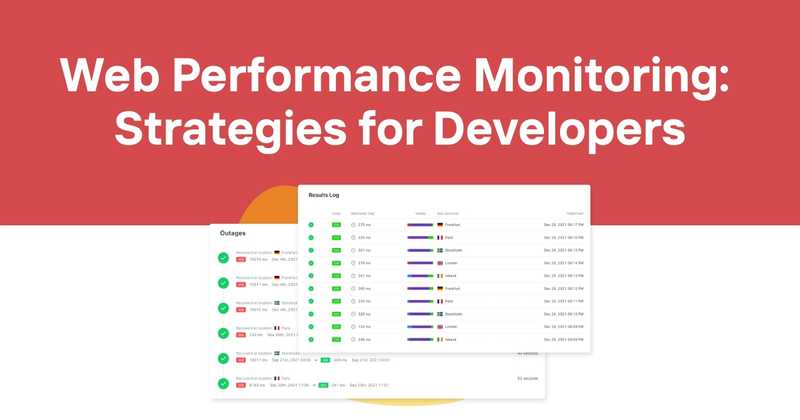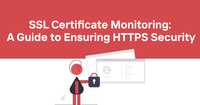Web Performance Monitoring: Strategies for Developers
Introduction
It's really necessary in today's digital world that a website runs smoothly and be highly reliable. As a developer, the seamless performance and efficiency of your web applications are just about as crucial as making sure they create an excellent user experience. This deep-diving article into the world of web performance monitoring delivers with practical strategies and insights to optimize your websites and APIs.
Table of Contents
- Understanding Web Performance Monitoring
- Key Metrics to Track
- Establish functional monitoring systems
- Performance monitoring: some tools and technologies
- Best Practices for Web Performance Optimization
- Handling Performance Issues
- Monitoring in Different Environments
- Future Trends in Web Performance Monitoring
- Conclusion
Understanding Web Performance Monitoring
Web performance monitoring might be viewed as the art of measurement, analysis, and optimization regarding speed and efficiency on any given website or web-based applications. It involves observing every other metric that may influence users' experiences with regard to page load times, server response times, and resource utilization.
As a developer, implementing a robust monitoring strategy allows you to:
- Identify and resolve issues before they impact users
- Optimize resource usage and reduce costs
- Improve user experience and satisfaction
- Meet service level agreements (SLAs) and performance benchmarks
Key Metrics to Keep Track Of
The following should be given importance in monitoring web performance effectively:
-
Page Load Time: Time taken to completely load all the elements on the page and to make it interactive.
-
Time to First Byte: Time difference between when the browser requests a page and actually receives the first byte of information.
-
First Contentful Paint (FCP): Time taken until the first content has appeared on screen.
-
Largest Contentful Paint (LCP): The time taken to paint the largest contentful element.
-
First Input Delay (FID): The time between a user's first interaction and the browser responding to that interaction.
-
Cumulative Layout Shift (CLS): This represents visual stability by measuring the layout shift unexpectedly.
-
Error Rates: Of total requests, those ending in errors.
-
Response Time: Time taken by a server to get back to a request.
-
CPU and Memory Usage: The amount of resources consumed on the server-side.
-
Throughput: Quantity of requests processed during a unit amount of time.
Establishment of functional monitoring systems.
Implementation of an integrated monitoring system involves the following:
-
Objectives Setting: Be objective of what should be attained from this monitoring.
-
Selection of Monitoring Tools: Choosing the appropriate tools best suited to the objectives and technical requirements.
-
Alerts: a notification if the values of the metric exceed a certain threshold.
-
Establish Baselines: Identify normal levels of performance to show variances.
-
How to Realize Logging: Give detailed logs for bug diagnosis and further analysis.
-
Dashboard Creation: Create visualizations that communicate key metrics easily monitored.
-
Continual Improvement: Provide continual monitoring strategy review and improvement.
Tools and Technologies for Performance Monitoring
Several tools are at your disposal for web performance follow-up.
-
Browser Developer Tools: In-built features allowing performance analysis and debugging.
-
Lighthouse: Free, open-source tool for auditing web pages with respect to performance.
-
WebPageTest lets you run speed tests from different locations using real browsers.
-
New Relic: Offers full-stack observability with performance monitoring.
-
Datadog: A monitoring and analytics platform for servers, databases, and applications.
-
Prometheus: Open source monitoring and alerting toolkit.
-
Grafana : Visualization/analysis platform for metrics coming from different data sources.
-
Odown: A tool, purely developed to monitor uptime and performance of websites and APIs.
Other factors include ease of use of the tool, integrations possible and cost-effectiveness of the tool.
Best Practices to Optimize Web Performance
To improve web performance, implement these best practices:
-
Optimize Images: Compress and resize images, reducing size.
-
Minify and Compress Resources: Minification reduces the file size of CSS, JavaScript, and HTML.
-
Implements caching: Browser and server-side caching may be implemented to store frequently accessed data.
-
Use Content Delivery Networks: This will enable distribution of content across different geographies.
-
Database Query Optimization: Enhancing query performance, including indexing.
-
Implement Lazy Loading: Load non-critical resources only when needed.
-
Minimize HTTP Requests: Basically, concatenate files and use CSS sprites.
-
Enable Gzip Compression: Compress server responses for faster transfers.
-
Optimize Critical Rendering Path: Prioritize above-the-fold content loading.
-
Use asynchronous loading: An asynchronously loaded script can't block.
Handling Performance Issues
Observe the following when problems in performance arise:
-
Problem Identification: Use monitoring tools to identify the source of the problem.
-
Analyze Root Cause: Look into logs and metrics to see what actually caused this.
-
Develop Solution: Present a plan of action toward the solution of the problem with the findings.
-
Implement and Test: Implement the solution into a controlled environment before deployment.
-
Monitor Results: After implementing the fix, closely monitor the results.
-
Documentation and Lessons Learned: Record the problem and solution along with experience gained for future reference.
Handling Performance Issues
When performance issues arise, follow these steps:
-
Identify the Problem: Use monitoring tools to pinpoint the source of the issue.
-
Analyze Root Cause: Investigate logs and metrics to determine the underlying cause.
-
Develop a Solution: Create a plan to address the issue based on your findings.
-
Implement and Test: Apply the solution in a controlled environment before deploying.
-
Monitor Results: Closely track performance after implementing the fix.
-
Document and Learn: Record the issue, solution, and lessons learned for future reference.
Monitoring in Different Environments
Effective monitoring strategies may vary across different environments:
Development Environment
- Focus on code-level performance optimization
- Use profiling tools to identify bottlenecks
- Implement unit tests for performance
Staging Environment
- Simulate production-like conditions
- Conduct load testing and stress testing
- Validate monitoring configurations
Production Environment
- Implement real-user monitoring (RUM)
- Set up synthetic monitoring for critical paths
- Use distributed tracing for complex systems
Cloud Environments
- Leverage cloud-native monitoring solutions
- Monitor auto-scaling behaviors
- Track costs associated with performance
Future Trends in Web Performance Monitoring
Stay ahead of the curve by keeping an eye on these emerging trends:
-
AI-Powered Analytics: Machine learning algorithms to predict and prevent issues.
-
Edge Computing Monitoring: Monitoring solutions tailored for edge computing environments.
-
Real-Time Observability: Increased focus on real-time insights and anomaly detection.
-
Web Vitals Evolution: Continued refinement of Core Web Vitals metrics.
-
Privacy-Focused Monitoring: Solutions that prioritize user privacy in data collection.
-
Serverless Monitoring: Specialized tools for monitoring serverless architectures.
-
IoT Integration: Monitoring solutions that incorporate data from IoT devices.
Conclusion
Web performance monitoring can be pretty much a major concern in modern web development. Keeping an eye on the right metrics, using effective monitoring techniques, and being up-to-date with recent and updated tools-all these have significant roles in ensuring that web applications provide great user experiences. Web performance optimization is always iterative.
Periodically revisit your monitoring setup configuration, stay informed of new emerging best practices, and actively focus on performance issues.
The ultimate painkiller for a developer, a service like Odown would grant a full suite of website and API performance tracking. And so, with these tools at your fingertips, you can then spend more time building fantastic applications, keeping them fast, reliable, and always available to your users.



